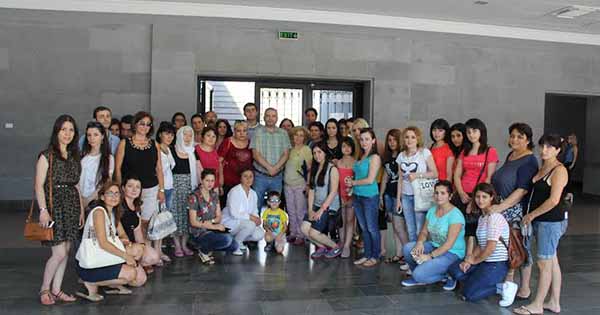“Diaspora” Summer School Program participants visited Tsitsernakaberd and Geghard Monastery

There is no Diaspora Armenian who hasn’t visited the Tsitsernakaberd Armenian Genocide Memorial Complex at least once during his or her visit to Armenia. The participants of the “Diaspora” Summer School Program had been waiting for that visit for a long time. They laid flowers in front of the eternal flame, performed Komitas’s songs and respected the memory of the canonized martyrs with a moment of silence.
Afterwards, the participants walked towards the Armenian Genocide Museum-Institute where they took a tour, saw and relived the horrors of the Armenian Genocide. Journalist Liana Petrosyan from Rostov-na-Don said she was impressed with not only the emotional atmosphere at the museum, but also the large amount of facts and materials that can eliminate the policy of denial of the Armenian Genocide.
After the visit, the participants had a chance to meet with Director of the Armenian Genocide Museum-Institute Hayk Demoyan and ask him their questions of concern.
The Diaspora Armenian teachers were mainly interested in how the architects having designed the monument interpreted the symbol of the complex since there were several prevailing views. “When I became the director of the museum-institute, there was quite a serious problem since people were criticizing us for not having a clear understanding of the symbol. They would link the presence of 12 columns of the memorial complex to the number of Armenian vilayets, which was definitely wrong, or to the number of intellectuals who fell victim to the Armenian Genocide. The solution was to find the architects and take signatures from them, stating their interpretations, and that’s exactly what we did. The memorial complex’s co-architect Sasun Kalashyan helped us. In the beginning, the architects had planned to build six columns, but while planning, they felt that six columns wouldn’t be aesthetically nice and they doubled the number of columns. It was done due to the rules of architectural proportion,” Mr. Demoyan clarified. He also mentioned that only symbolic thing is the 15 meter diameter of the complex that symbolizes the year 1915. “The large column was one-vector until the last moment. Only during the launch of construction did the architects decide to split the column in two, symbolizing the branches of a tree that move towards the sun, meaning life,” the director of the museum-institute added.
The participants also asked if the memorial complex portrayed inclination. “We interpret it that way, saying that it looks like women in mourning. However, the foundation is not inclination, but opening up. You’ve probably seen how a plant cracks through the asphalt and blossoms. The structure symbolizes life and how a person can get back on his feet after the suffering,” Demoyan mentioned. He also told the participants how special paper is made from the flowers brought to the memorial complex, how postcards are made from those flowers and granted to those visiting the museum. “There are people who bring the manuscript memoirs and important documents of their ancestors and ask how they can help us. True, there aren’t many people like that, but we have to be grateful to those people,” Hayk Demoyan concluded.
After the visit to the Armenian Genocide Museum-Institute, the participants headed towards Geghard Monastery where they lit candles, witnessed the ceremony of blessing of newlyweds and took sacred water to take to their relatives living abroad.
Amalya Karapetyan
4th year student of the Faculty of Journalism of Yerevan State University




 Արևելահայերեն
Արևելահայերեն Արևմտահայերեն
Արևմտահայերեն Русский
Русский






